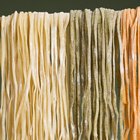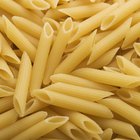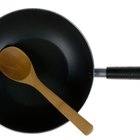
For value-conscious cooks, dry pasta is one of the truly great cooking ingredients. It's versatile, nutritious, inexpensive and even the pickiest of eaters usually like it. Aside from those culinary virtues, it's also durable. Dry pasta noodles can be stored in your pantry or cupboard for extended periods, usually without any special precautions. Although it doesn't last forever, its usable life is limited more by quality than food safety considerations.
A Dry Pasta Primer
Most dry pasta is made with only two ingredients: water and a specific type of wheat, called durum. Durum is the oldest form of wheat that's still widely grown and used, and most of it goes into pasta. It's mixed into a stiff dough and then extruded through a metal die, forming it into a range of shapes. Once dried, the pasta is as hard and durable as grain or beans. Some pasta includes eggs, spinach, tomatoes, squid ink or other ingredients to enrich or color it. These specialty noodles are just as durable as the plain variety when they're properly stored.
Pasta Dating and Freshness
Most brands of dry pasta are stamped with a freshness date, or "use-by" date. That's the manufacturer's estimate of how long the pasta will retain its flavor and nutrition. Manufacturers want you to continue buying their product regularly, so those dates tend to be conservative. Most dried pastas retain their best quality for up to two years on the shelf, and are still perfectly usable past that date. Their flavor and texture can deteriorate over time, but unless they're contaminated in some way, the noodles are still safe to use.
Evaluating Elderly Pasta
Pasta is durable but not indestructible, so if you find yourself working with pasta that's old or of uncertain age, it's important to use a little common sense. If the noodles are blotchy or discolored, they've probably been contaminated and you should throw them out. That's also the case if you find insects, egg cases or larvae in the noodles. If your pasta appears to be sound and doesn't smell musty, boil a small amount of water and cook up a few noodles as a test. If their flavor and texture are OK, feel free to use them.
Storing Your Pasta
You can improve the lifespan of your pasta through careful storage. Always keep it in a cool, well-ventilated storage area, because heat and humidity degrade pasta's quality. If you're in an especially humid climate, or if insects and other pests are a threat, transferring your noodles to an airtight jar or storage container can help keep them usable for longer. Pasta made with whole grains can be more perishable than conventional pasta, because of the natural oils in the grain. To prevent the oils from becoming rancid, use whole-grain pasta within a few months or store it -- well wrapped -- in your freezer.
Related Articles
How Long Will Uncooked Pasta Keep in ...

Can Fresh Pasta Be Dried Even if It Has ...

Calories in Gluten Free Pasta

Can I Freeze Wheat Berries?

How to Make Spaghetti Noodles

How to Boil Pasta Noodles

How to Store Balsamic Vinegar

Calories in Pasta With Marinara Sauce

Do You Need to Cook Fresh Made Lasagna ...

Alternative Flours to Make Pizza

How to Make a Quick Snack Made of Ramen ...

How to Know If Pork Chops Have Gone Bad

Calories in Pasta Noodles

How to Buy & Cook Lentils
Do You Have to Cook Lasagna Before ...

Calories in Udon Noodles

Does Falafel Go Bad?

How to Fry Raw Spaghetti

How Long Do I Cook Vermicelli?

How to Cook Miracle Noodles in the ...
References
- On Food and Cooking: The Science and Lore of the Kitchen; Harold McGee
- Recipe Tips: Pasta Handling, Safety & Storage
- Eat By Date: Shelf Life of Pasta
Writer Bio
Fred Decker is a trained chef and prolific freelance writer. In previous careers, he sold insurance and mutual funds, and was a longtime retailer. He was educated at Memorial University of Newfoundland and the Northern Alberta Institute of Technology. His articles have appeared on numerous home and garden sites including GoneOutdoors, TheNest and eHow.
Photo Credits
Stockbyte/Stockbyte/Getty Images